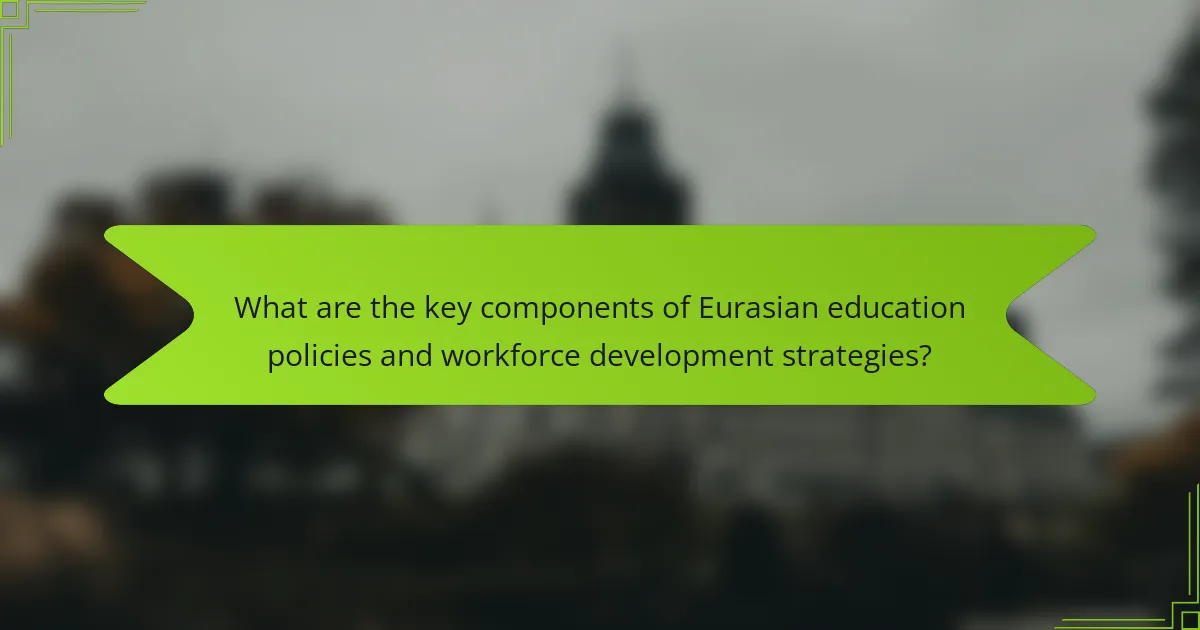The article examines the intersection of Eurasian education policies and workforce development strategies, focusing on key components such as alignment with labor market needs, investment in vocational education, and the promotion of lifelong learning. It highlights how various countries in the region, including Finland, Kazakhstan, Russia, and Azerbaijan, implement tailored approaches to enhance employability and economic growth by integrating education with industry requirements. The article also discusses future trends, including the integration of technology in education, a shift towards skills-based training, and a focus on inclusivity to address disparities in access and quality. Evidence from organizations like the World Bank and UNESCO supports the notion that targeted investments in these areas lead to improved workforce outcomes and enhanced economic competitiveness in Eurasia.

What are the key components of Eurasian education policies and workforce development strategies?
Key components of Eurasian education policies and workforce development strategies include alignment with labor market needs, investment in vocational education, and promotion of lifelong learning. These strategies aim to enhance employability and economic growth. Countries in the region often focus on integrating education with industry requirements. This ensures that graduates possess relevant skills. Additionally, there is a strong emphasis on international cooperation in education. Collaborative programs with foreign institutions help improve educational standards. Evidence shows that countries investing in these areas experience better workforce outcomes. For instance, the World Bank reports improved job placement rates in nations that prioritize vocational training.
How do education policies influence workforce development in Eurasia?
Education policies significantly influence workforce development in Eurasia by aligning educational outcomes with labor market needs. These policies shape curriculum standards, vocational training programs, and higher education initiatives. For instance, countries like Kazakhstan have implemented reforms to enhance technical and vocational education, addressing skill shortages in key sectors. In Russia, the integration of industry partnerships into educational frameworks helps ensure that graduates possess relevant skills. Furthermore, education policies that promote STEM fields have been linked to increased innovation and economic growth. A report by the World Bank highlights that investment in education leads to higher employment rates and productivity. Thus, effective education policies are crucial for creating a skilled workforce that meets the demands of evolving economies in Eurasia.
What specific education policies are prevalent in Eurasian countries?
Eurasian countries implement various education policies focused on improving access and quality. Many nations prioritize universal primary education to ensure foundational skills for all children. Secondary education policies often emphasize vocational training to align with labor market needs. Countries like Kazakhstan and Russia promote STEM education to enhance technological competencies.
Higher education policies frequently support international collaboration and student exchanges. There is a growing trend towards integrating digital learning platforms across the region. Education reforms often aim to increase public funding for schools and universities. Additionally, policies encourage partnerships between educational institutions and industries to enhance workforce readiness.
How do these policies address skill gaps in the workforce?
These policies address skill gaps in the workforce by aligning educational curricula with industry needs. They promote partnerships between educational institutions and employers. This collaboration ensures that training programs reflect current job market demands. Additionally, policies often include funding for vocational training initiatives. These initiatives are designed to equip individuals with relevant skills. Research indicates that regions implementing such policies see a decrease in unemployment rates. For example, a study by the OECD found that targeted skills training can enhance employability by 30%. Overall, these strategies aim to create a more skilled workforce that meets the evolving needs of industries.
What are the challenges faced in aligning education policies with workforce needs?
Aligning education policies with workforce needs faces several challenges. One major challenge is the rapid pace of technological change. This results in a skills gap where educational institutions cannot keep up with industry demands. Another challenge is the lack of communication between educational institutions and employers. This gap leads to misalignment in curriculum development and job market requirements. Additionally, funding constraints can limit the ability of educational institutions to adapt programs effectively. A study by the World Economic Forum indicates that 54% of employees will require reskilling by 2022 due to changing job requirements. Furthermore, diverse regional economic conditions across Eurasia complicate the standardization of education policies. These factors collectively hinder the effective alignment of education policies with the evolving needs of the workforce.
What are the barriers to effective policy implementation?
Barriers to effective policy implementation include lack of resources, inadequate stakeholder engagement, and insufficient training. Limited financial resources hinder the necessary actions for policy execution. Stakeholder engagement is crucial; when stakeholders are not involved, policies may fail to meet real needs. Additionally, training gaps can lead to misunderstandings of policy goals and procedures. Research shows that ineffective communication contributes to implementation challenges. A study by the World Bank highlights that 70% of policies fail due to insufficient capacity and resources. Addressing these barriers is essential for successful policy outcomes.
How do socio-economic factors impact education and workforce strategies?
Socio-economic factors significantly impact education and workforce strategies. These factors determine access to quality education and resources. For instance, families with higher income can afford better educational opportunities. Conversely, low-income families may struggle to provide necessary support for their children’s education.
Research shows that socio-economic status correlates with academic achievement. According to the National Center for Education Statistics, students from low-income families are less likely to graduate high school. This affects their employability and future workforce participation.
Moreover, socio-economic conditions influence the types of skills taught in education systems. Areas with higher unemployment may prioritize vocational training to meet local job demands. In contrast, wealthier regions may focus on advanced education and innovation.
Overall, socio-economic factors shape educational outcomes and workforce readiness. They create disparities that affect individual and collective economic growth.

How do different Eurasian countries approach education and workforce development?
Different Eurasian countries have varied approaches to education and workforce development. For instance, Finland emphasizes a student-centered model with a strong focus on teacher training. In contrast, countries like Kazakhstan are reforming their educational systems to align more closely with global standards. Russia prioritizes vocational training alongside traditional education to enhance employability. Meanwhile, countries such as Azerbaijan invest in technical education to support economic diversification. Each country tailors its policies based on economic needs and cultural contexts. These strategies reflect the diverse educational landscapes across Eurasia, aiming to meet both local and global workforce demands.
What are the best practices from leading Eurasian countries?
Leading Eurasian countries implement several best practices in education and workforce development. These practices include integrating vocational training with academic education. Countries like Germany and Switzerland serve as models with their dual education systems. These systems combine classroom instruction with hands-on experience in industries.
Additionally, countries prioritize partnerships between educational institutions and businesses. This collaboration ensures curricula align with market needs. For example, Kazakhstan has established initiatives linking universities with local industries.
Moreover, leading countries invest in continuous professional development for educators. This practice enhances teaching quality and adapts to changing workforce demands. Countries such as Finland emphasize teacher training and support.
Lastly, data-driven decision-making is a common approach. Countries utilize labor market analytics to inform educational policies. This practice helps in anticipating future skills requirements. Overall, these best practices foster a more responsive and skilled workforce in Eurasian countries.
How do these practices enhance employability among graduates?
These practices enhance employability among graduates by equipping them with relevant skills. Graduates gain practical experience through internships and industry collaborations. This hands-on experience makes them more attractive to employers. Additionally, these practices foster critical thinking and problem-solving abilities. Employers value these skills in dynamic work environments. Networking opportunities arise from these practices, connecting graduates with industry professionals. Research indicates that graduates who participate in such initiatives have higher job placement rates. According to a study by the World Economic Forum, 65% of employers prioritize candidates with practical experience.
What role do public-private partnerships play in these practices?
Public-private partnerships (PPPs) facilitate collaboration between government entities and private organizations in education and workforce development. These partnerships enhance resource allocation and improve educational outcomes. For instance, they can provide funding, expertise, and innovative solutions to address skills gaps. PPPs often lead to the development of tailored training programs that align with industry needs. This alignment ensures that graduates possess relevant skills for the job market. Evidence shows that countries utilizing PPPs in education experience higher employment rates among graduates. Additionally, successful PPPs can foster continuous dialogue between educators and employers. This ongoing communication helps adapt curricula to changing market demands.
What lessons can be learned from comparative analysis of Eurasian education systems?
Comparative analysis of Eurasian education systems reveals key lessons regarding educational effectiveness and workforce alignment. First, it highlights the importance of integrating vocational training with academic education. Countries like Germany demonstrate successful models that combine theory with practical skills. Second, the analysis shows that diverse educational frameworks can lead to varied outcomes in student performance and employability. For instance, Finland’s emphasis on teacher autonomy correlates with high student achievement. Third, the study underscores the need for policy adaptability to local contexts. Countries that tailor their education systems to specific cultural and economic needs show improved results. Lastly, collaboration between educational institutions and industries is essential. This partnership enhances curriculum relevance and prepares students for market demands. These lessons emphasize the interconnectedness of education policies and workforce development strategies across Eurasia.
How do cultural differences influence educational outcomes?
Cultural differences significantly influence educational outcomes by shaping students’ attitudes, behaviors, and expectations. These differences affect communication styles, learning preferences, and classroom dynamics. For instance, collectivist cultures may emphasize group work and collaboration, while individualist cultures prioritize personal achievement. Research indicates that students from diverse cultural backgrounds may face challenges if educational systems do not align with their cultural norms. A study by the Organisation for Economic Co-operation and Development (OECD) found that cultural context impacts student engagement and motivation, ultimately affecting academic performance. Additionally, teachers’ cultural awareness can enhance their effectiveness in diverse classrooms, leading to improved educational outcomes.
What can countries adopt from each other’s strategies?
Countries can adopt successful educational frameworks and workforce development models from each other. For instance, Finland’s emphasis on teacher autonomy and student-centered learning has been effective in improving educational outcomes. Similarly, Germany’s dual education system integrates apprenticeships with academic education, enhancing workforce readiness.
Incorporating technology in education, as seen in Estonia, can improve digital literacy among students. Countries can also learn from Singapore’s focus on continuous professional development for teachers, which fosters high teaching standards.
Adopting these strategies can lead to improved educational systems and better-prepared workforces. Evidence from international assessments, like PISA, shows that these approaches correlate with higher student performance.

What future trends are expected in Eurasian education policies and workforce development?
Future trends in Eurasian education policies and workforce development include increased integration of technology and a focus on skills-based training. Governments are prioritizing digital literacy in curricula to prepare students for a tech-driven job market. Collaborative initiatives between educational institutions and industries are expected to grow, ensuring that training aligns with labor market needs.
Additionally, there is a shift towards lifelong learning models, enabling workers to adapt to changing job requirements. Countries are also emphasizing inclusivity in education to address disparities in access and quality. Data from UNESCO indicates that these trends aim to enhance economic competitiveness in the region.
How is technology shaping the future of education and workforce strategies?
Technology is transforming education and workforce strategies by enhancing accessibility and personalization. Online learning platforms enable students to access resources from anywhere. This flexibility supports diverse learning styles and paces. For workforce strategies, technology facilitates remote work and global collaboration. Companies increasingly adopt digital tools for training and employee engagement. According to a report by McKinsey, 87% of companies are experiencing skill gaps due to digital transformation. This necessitates continuous learning and adaptation in both education and workforce sectors. Additionally, data analytics help institutions tailor programs to meet industry demands. These advancements ensure that education aligns with current and future job market needs.
What innovations are being implemented in educational institutions?
Educational institutions are implementing various innovations to enhance learning experiences. These include the integration of technology in classrooms, such as interactive whiteboards and tablets. Blended learning models combine traditional teaching with online resources. Personalized learning approaches cater to individual student needs and learning paces. Collaborative learning environments promote teamwork and communication skills. Data analytics are used to track student progress and improve educational outcomes. Many institutions are adopting project-based learning to foster critical thinking. Additionally, partnerships with industries provide real-world experience and skills training. These innovations aim to prepare students for the evolving workforce.
How do these innovations prepare students for future job markets?
Innovations in education prepare students for future job markets by equipping them with relevant skills. These innovations include technology integration, project-based learning, and interdisciplinary approaches. Technology integration familiarizes students with digital tools used in various industries. Project-based learning enhances problem-solving and teamwork abilities. Interdisciplinary approaches foster critical thinking and adaptability. Research shows that 65% of children entering primary school will work in jobs that do not yet exist. This highlights the need for educational innovations that focus on skills like creativity and collaboration. By aligning curricula with industry needs, students become more competitive in the job market.
What role do international collaborations play in shaping future policies?
International collaborations play a crucial role in shaping future policies by facilitating knowledge exchange and best practices. These partnerships enable countries to address common challenges in education and workforce development. Collaborative initiatives often lead to the harmonization of standards and regulations across borders. For instance, joint research projects can inform policy decisions based on shared data and insights. Additionally, international collaborations can mobilize resources and funding for educational programs. Programs like Erasmus+ exemplify how cross-border cooperation enhances educational opportunities. Ultimately, these collaborations foster innovation and adaptability in policy-making processes.
How can cross-border partnerships enhance workforce skills?
Cross-border partnerships can enhance workforce skills by facilitating knowledge exchange and resource sharing. These collaborations allow organizations to access diverse training methodologies and best practices from different countries. For instance, companies can implement innovative training programs adapted from their partners’ successful strategies. Additionally, cross-border partnerships can provide exposure to international markets, fostering adaptability and cultural awareness among employees. According to a study by the World Economic Forum, companies engaged in international partnerships reported a 20% increase in employee skill levels due to collaborative training efforts. Furthermore, these partnerships often lead to joint certifications, enhancing the credibility of workforce skills across borders.
What are the expected outcomes of these collaborations?
The expected outcomes of collaborations in Eurasian education policies and workforce development strategies include enhanced skill alignment with market demands. These collaborations aim to create a workforce that meets the evolving needs of industries. Improved educational curricula will result from integrating feedback from employers. This ensures that graduates possess relevant skills and knowledge. Additionally, increased employability rates are anticipated as students gain practical experience through partnerships. Enhanced cross-border educational exchanges will foster cultural understanding and collaboration. Finally, these collaborations can lead to economic growth by producing a more competent workforce.
What practical steps can stakeholders take to improve education and workforce alignment?
Stakeholders can improve education and workforce alignment by fostering partnerships between educational institutions and industries. These partnerships can facilitate curriculum development that reflects current job market needs. Stakeholders should also promote internships and apprenticeships to provide students with practical experience. Regularly updating training programs to match evolving skills requirements is essential. Engaging in continuous dialogue between educators and employers can ensure alignment remains relevant. Additionally, stakeholders can utilize data analytics to assess workforce trends and adjust educational offerings accordingly. Implementing these steps can lead to a more skilled workforce that meets the demands of the economy.
What strategies can educators implement to enhance curriculum relevance?
Educators can enhance curriculum relevance by integrating real-world applications into lessons. This strategy connects academic content to practical experiences. For instance, project-based learning allows students to solve real-life problems. According to a study by the Buck Institute for Education, project-based learning increases student engagement and retention. Additionally, incorporating local industry input into curriculum design ensures alignment with workforce needs. Research by the World Economic Forum emphasizes the importance of skills development for future job markets. Lastly, utilizing technology in the classroom can facilitate personalized learning experiences. A report by the International Society for Technology in Education highlights improved student outcomes through tech integration.
How can industries contribute to shaping educational programs?
Industries can contribute to shaping educational programs by providing insights into workforce needs. They can collaborate with educational institutions to align curricula with current job market demands. This ensures that students acquire relevant skills and knowledge. For example, tech companies often partner with universities to develop programs in software engineering. Such collaborations can lead to internships and hands-on training opportunities. These experiences enhance student employability and readiness for the workforce. Additionally, industries can offer funding and resources for educational initiatives. This support can improve infrastructure and access to technology in schools. Overall, industry involvement helps create a more skilled and competent workforce.
The main entity of the article is the intersection of Eurasian education policies and workforce development strategies. The article examines key components such as alignment with labor market needs, investment in vocational education, and promotion of lifelong learning, highlighting how these strategies enhance employability and economic growth. It discusses the influence of education policies on workforce development, prevalent educational practices across Eurasian countries, and the challenges faced in aligning these policies with industry demands. Additionally, the article explores the role of international collaborations, socio-economic factors, and best practices in shaping effective educational frameworks and workforce readiness.